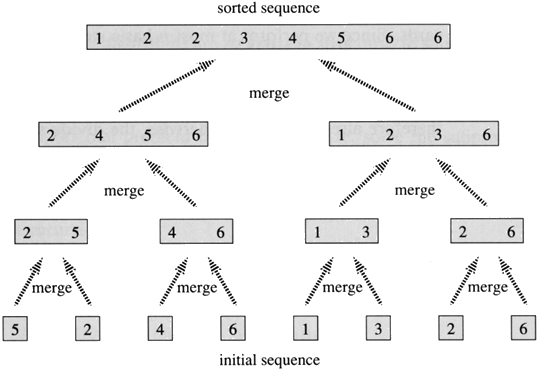Notes for July 13, 2005
Topics
Comparable interface
With primitives like ints, it's easy to compare their values
against one another, since Java has operators to do that like
< and >. However, for objects, Java has no way of
knowing how the programmer wants objects of a certain class to relate to
one another. Enter the Comparable
interface. The Comparable inteface is defined as follows:
public interface Comparable {
public int compareTo(Object o);
}
The compareTo method should have the behavior such that if you
made the call x.compareTo(y), then
| compareTo returns |
when |
| some negative integer |
x < y |
| 0 |
x = y |
| some positive integer |
x > y |
Sorting
Of the various sorting methods out there, we will only be interested in
merge sort for now. The code is on handout #15. The running time for merge sort
is O(n log n). To see why, merge sort divides the list in half
repeatedly until it reaches a one-element list (see picture below). How
many times can it divide a list of n elements in half? The
answer is log2n (If you don't understand why, make
sure you ask!). After it sorts each half, it merges them together. If
each list has n/2 elements (at the second level in the picture
below), then the merge operation takes n steps, because it need
only look at each element once while performing the merge. Notice that at
the third level, two merges are performed. Each merge operates on lists
of n/4 elements. That means each merge takes n/2 time.
Since there are two merges, the total time at that level is n
time. At the level below that, there are four merge operations performed,
and each merge takes n/4 time for a total time of (drumroll,
please) n time. Since there are log2n levels
and each level takes n time, the total time is O(n
log2n). We can omit the base (2) and just write
it as O(n log n).

(image linked from
http://www.personal.kent.edu/~rmuhamma/Algorithms/MyAlgorithms/Sorting/mergeSort.htm)

